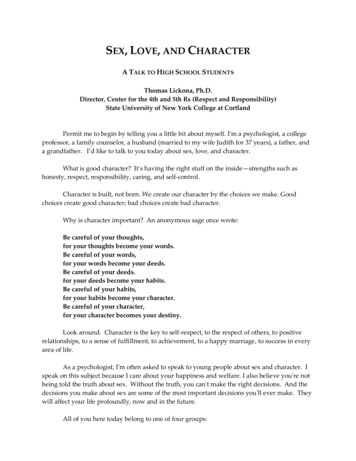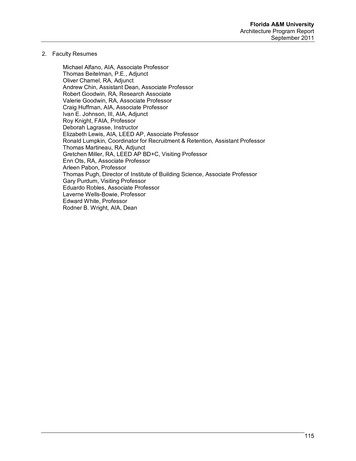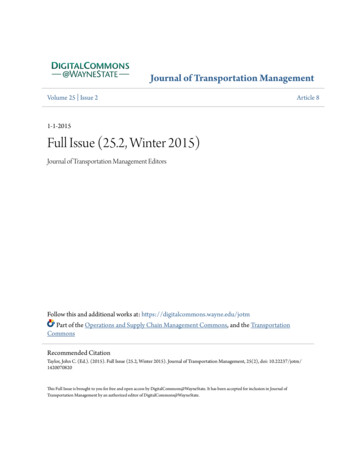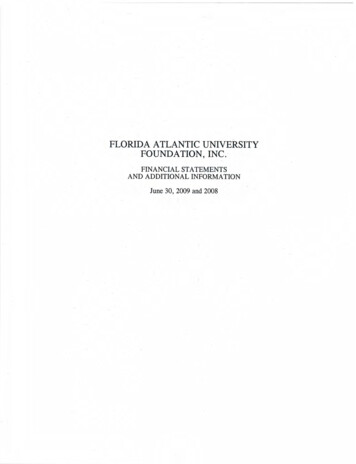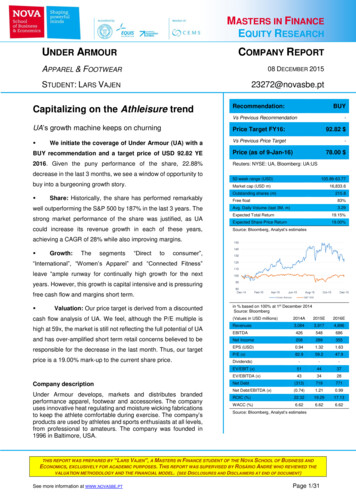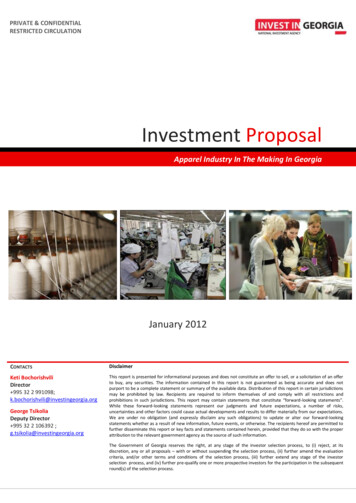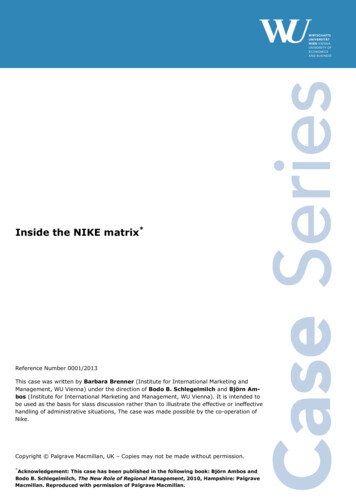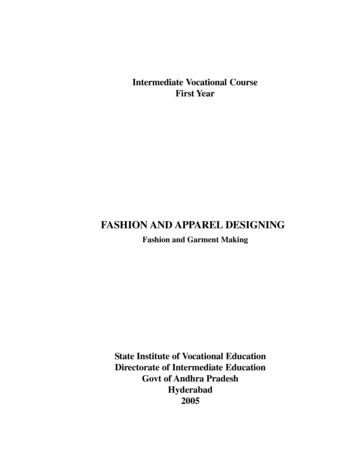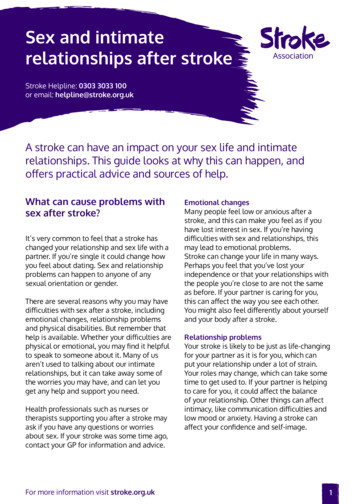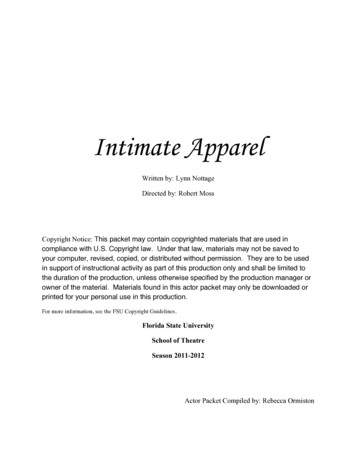
Transcription
Intimate ApparelWritten by: Lynn NottageDirected by: Robert MossCopyright Notice: This packet may contain copyrighted materials that are used incompliance with U.S. Copyright law. Under that law, materials may not be saved toyour computer, revised, copied, or distributed without permission. They are to be usedin support of instructional activity as part of this production only and shall be limited tothe duration of the production, unless otherwise specified by the production manager orowner of the material. Materials found in this actor packet may only be downloaded orprinted for your personal use in this production.For more information, see the FSU Copyright Guidelines.Florida State UniversitySchool of TheatreSeason 2011-2012Actor Packet Compiled by: Rebecca Ormiston
Intimate Apparel:Selected Production HistoryNotableFebruary 2003:Co-Produced/Co-Commissioned, World Premiere by CENTERSTAGE (Maryland, MD)April 2003:Co-Produced/Co-Commissioned, South Coast Repertory Theatre (Costa Mesa, CA)March 2004:Roundabout Theatre (New York, NY): off-Broadway debutJuly 2004:Mark Taper Forum (Los Angeles, CA)January 2005:Steppenwolf Theatre (Chicago, IL)February 2006:Syracuse Stage (Syracuse, NY)RecentOctober 2010:Two River Theatre Company (NJ)In Florida2006:Gable Stage Theatre (Coral Gables)2008:Laura PelsTheatre (Orlando)
GLOSSARY This glossary provides a concise definition for some of the terms you will findin Intimate Apparel. They are organized by page number and scene.N/A in the page number column means that the term is in the original script,but not in the version you have for rehearsal.If you would like to know more about a term, or if you would like the sourceof a term, or if you would like me to include a term not in this glossary, pleasefeel free to ask!ACT ONEScene 1Pg. 2Ragtime2The war4Rooming Housen. A style of jazzpiano musicdeveloped around1900.Characteristics: atwo‐four rhythmbase and asyncopated melody.While Americaengaged in multiplewars during theNineteenth century,Mrs. Dickson’sbiography steers usto believe that she isreferencing the CivilWar (1861‐1865).A facility wherepeople can rent aroom for a period ofweeks, months, oryears. Commonareas, such as thedining room, andlaundry room areshared. A landlordholds full rights tothe building, andwho can rent.S.D. (A clumsyragtime melodybleeds in from theparlor.)MRS. DICKSON: Iknow your mamasince before thewar.ESTHER: And I beenliving in thisrooming house forso long
3Saperstein’s5Courtship Partiesand Dances6Opiates/Opium7PanamaA department store.Still available insome towns in NYand in other states.A remnant ofVictorian courtshiprituals, each classheld specific socialfunctions for thepurpose of securing aspouse. There wasalso a courtshipseason that began inthe spring, usuallyfrom April to July.A highly addictivenarcotic, known to bea popularrecreational drugduring the 19th and20th century. Opiumdens were prevalentin big cities like NewYork and SanFrancisco.Please seegeographicinformation. (maps)MRS. DICKSON: Butnot every man hasthe good sense toshop at—ESTHER and MRS.DICKSON:Saperstein’s.ESTHER: But he’sbeen coming tothese parties fornearly two years MRS. DICKSON: Iforgave hisinfatuation with theopiates.Scene 29Tenderloin9The Corset DebateAlso known as thered‐light district inManhattan. Pleasesee thesupplementalmaterial onManhattan (maps)A debate thatemerged during thelate 1800s and earlyVAN BUREN: I feellike a tart from theTenderloin.ESTHER: Well, it therage. Some ladiesain’t even wearing
9Suffragettes12Divorce14Literacy15Trolley15Orchard Street16Ferdinand de1900s amongwomen suffragettes.Please see thecasebook regardingthe corset debates.Women whostruggled for yearsto secure the votefor women in 1920.Suffragettes begantheir call for equalvoting rights as earlyas the pre‐Civil Warperiod, but did notgain prominenceuntil after the CivilWar.Please see thecasebook sectionabout women andthe stigma of divorceduring the earlyTwentieth century.Please see the chartand informationconcerning literacyrates in America(casebook and thispacket)A streetcar thatoperates on rails andfollows a regularroute.A famous street inthe Lower East Sideof Manhattan,historically knownfor its tenementswhich housedthousands ofimmigrants, and theplethora of Jewish‐owned garmentshops.The Frenchthe corsets inprivate most galsdon’t like ‘em, evenfine ladies likeyourself.VAN BUREN: You’renot one of thosesuffragettes, areyou?VAN BUREN: I’drather not be adivorcee , at my ageit would provedisastrous.ESTHER: The fact is Ican’t read.ESTHER: I take thetrolley downtown toOrchard Street.See above line.GEORGE: They say a
Lessepsdeveloper of theSuez Canal, heattempted tocomplete thePanama Canal. Hewas later implicatedin the Panama CanalScandal whichinvolved bribesbetween Ferdinandde Lesseps andpoliticians andjournalists.mad Frenchmendreamed up thisPanama project,Scene 318Orient18“Turn back sheetsfor fifty cents aday.”19Cirnati sausage20Rabbinical LawAn old‐fashioned andun‐PC way of saying“Asia” or the “East.”At the time, this termwas completelyacceptable. Thislocation is known toprovide luxurious,expensive goods.Become a maid, ordomestic helper— ananny. This was acommon line of workfor Black womencoming to the North.A type of Romaniansausage with a spicy,smoked flavor. It isthick intexture/width,tubular, and itscoloring resemblessalami.Please see theinformation aboutRomanian Judaism inthe casebook.MARKS: it comeright off the shipfrom the Orient.ESTHER: I’m afraidit was either learnto sew or turn backsheets for fiftycents a day.MARKS: Look at thesize of these hands.Like Cirnati,Romanian sausage.MARKS: It is therabbinical law, notmine.
Scene 4N/ACarpetbag21TemperanceMovement21Mother Hen21Mistress23Onliest23Satin foulard27The Great NorthernA bag or purse madeof carpet material,usually from anOriental rug. Thesebags were widelypopular in theNineteenth centuryand came in a varietyof sizes.At its strongest inthe 1800s before theCivil War. TheTemperanceMovement wasaggressive enoughwith its message ofliving a sober lifeand/or alcoholicconsumption inmoderation that thissentiment persistedinto the Twentiethcentury.One who fusses overanother in an over‐protective fashion,like a hen to herchicks. First knownuse of this word is in1873.In this sense, awomen who hasauthority overothers, includingslaves.Only, the only thingis A finely woven fabricthat usually has aprint, and is oftenused to makehandkerchiefs.Please seeS.D. (Esther bangs onthe door, then finallyenters carrying acarpetbag.)ESTHER: thatignorant oil isunforgiving. Best letit lie.MAYME: stopplaying mother hen.ESTHER: Anythingelse, mistress?MAYME: Onliest, Iain’t got the money ESTHER: that satinfoulard was made forthe finest ladies inParis.ESTHER: since I
Migration28Bert Williams28Cambric walkingsuit28Heliotropehandkerchief30“You got your mindin the gutter.”31“ and good menbefriend the devilovernight.”information in thepacket about TheGreat NorthernMigration.b. (1875‐1922) Awidely successfulBlack entertainer,comedian, recordingartists, andvaudevilleentertainer who alsoperformed inBlackface.A lightweight, plain‐weave cotton fabricsuit.A pinkish‐purplecoloredhandkerchief.A derogatoryexpression whichroughly translatesto: “you’re thinkingof nasty/trashythings and you’re notsupposed to.”A euphemism orexpression forsomeone who is all‐around good, butgives in for a sinfulvice, item, orpleasure. This alsodenotes anexchange: one’smorals for an itemthey shouldn’t havebut wantnonetheless.come North.MAYME: Only lastnight one of BertWilliams musicianssat up front ESTHER: Yes, hehere in my pocket ina cambric walkingsuit, he has aheliotropehandkerchief See above line.ESTHER: I’m beingserious and you gotyour mind in thegutter.GEORGE: I seenmonths of hard worklost in an eveningand good menbefriend he devilovernight.
Scene 532Corresponding32“Don’t set your clockby my habits.”n. of the v. correspond:To communicatewith, usuallyintimately orsecretively. Fun fact:corresponding alsoholds a sexualconnotation since themedieval period.Roughly translates to:“Don’t assume toknow how I act.”38Max FiedlerA notable Germanconductor andcomposer of the time.38Don Juan38Madison SquareGarden38BohemianA famous story abouta fictional andamorous libertine.This story has beenadapted numeroustimes into plays andoperas. In 1905, itwas performed forNew York audiencesby the PhilharmonicSociety.This is NOT the MSGwe know today, butanother indoorfacility that served asan entertainment hubfor the upper classes.n. “one who eithercuts himself off, or isby his habits cut off,ESTHER: Wecorresponding.That’s all.MRS. DICKSON:Esther, you’re toopractical a girl forthis.ESTHER: Don’t setyour clock by myhabits.VAN BUREN: I sawMr. Max Fiedler ofGermany conductselections from DonJuan.See above line.VAN BUREN: I’drather have gone tothe electric show atMadison SquareGarden VAN BUREN: MaybeI’ll be a bohemian, abohemian needn’t a
from society forhusband, she’s notwhich he is otherwise bound byfitted; especially anconvention.artist, literary man, oractor, who leads afree, vagabond, orirregular life, notbeing particular as tothe society hefrequents, anddespisingconventionalitiesgenerally.” (OED)ACT TWOScene 1 and 2 (scene 1 only has “Chattel”)555657ChattelThe U.S.A and theAmericas share along and uglyhistory of Africanslave labor.Children born toslaves were alsoknown as chattel.“Yellow, cotton and Definitioncane eyes.”forthcoming.CicadasA large, flyinginsect colloquiallyknown as locust.They are knownfor theirdistinctive,“whirring” noise.Although she’snever been toPanama, Estherwould be familiarwith Cicadas fromNorth Carolina.GEORGE: Myparents werechattel ESTHER: Yellow,cotton and caneeyes.ESTHER: andlistened for thesong of cicadas
58WorstedA firm cloth madefrom yarn.58Chupses58St. LucyA commonexpression ofamusement ordisdain inBarbados verbalcommunication,alternativelyknown as “suckingteeth.”The northern‐mostpart of Barbados.58Busylickum58Steel girders58Tamarind TreesESTHER: I’dmake you aworsted suit.GEORGE: S.D.(Chupses again.)GEORGE: I ain’been this idle sincea boy in St. Lucy.But thatbusylickum ain’‘ear nothing.n. A Barbados slang See above line.for “a nosyperson.”A support beamGEORGE: steelused ingirders as thick asconstruction.tamarind trees A tree native toSee above line.Africa, buttransported to theAmericas duringthe 1600s. It’s afruit bearing treethat can grow quitelarge: 40‐60 feethigh.
Scene 3N/ASnifter67LenoxA type of glass forbrandy andwhiskey. It is wideat the bottom, andnarrow towardsthe top with ashort stem.A town in NewYork.S.D. (Van Burensits on the bedcradling a snifterof brandy.)VAN BUREN:Anyway, I’mconsidering a visitwith friends inLenox thissummer Scene 480Duppy81Mulatto82HeiferA ghost ormalevolent spirit.Its origins are fromNorthwest Africa;the duppy is aprominent figurein Caribbeanfolklore.A person whoseancestry is half‐Black and half‐white. During theEighteenthcentury, a mulattowas someone witha Black and NativeAmerican heritage,but by 1905 theterm had come tomean any mixed‐race person withwhite heritage.Derogatory nameGEORGE: You lookas though you seena duppy.GEORGE: An oldmulatto man.MAYME: Well, she
for a heavy, slow,unintelligent oruseless person.This name isusually assigned towomen, comparingher to a cow.must be a cruelheartless heifer.Scene 6N/ATallit Katen“The Tallit katan isa fringed garmentworn either underor over one’sclothing byOrthodoxJewish.made ofwool or cotton, it isa poncho‐likegarment with ahole for the headand special twinedand knottedfringes known astzitzit attached toits four corners.”S.D. ([MARKS]removes his outerjacket, revealingthe fringes of hisTallit Katen.)
Maps of Manhattan, Then and NowManhattanA borough of New York City, the island of Manhattan is one of the most notable andrecognizable locations in the world. When people think of the “American Dream,” or of thenation itself, they often think of New York City itself and the Statue of Liberty. Below you willfind maps of the area so that you can begin to get a sense of Esther’s world. Please note thatthe older maps are a bit difficult to read, so I’ve included contemporary maps with clearlymarked street names. Also take note that almost all of these streets existed before 1905.Please let me know if you need a source for these maps. The antique ones came from ebay. Therest were provided by Googlemaps, or by New York tourist blogs.The FSU Strozier library has some beautiful, large maps of Manhattan in their collection.However, they are for in‐library use only. Regardless, I would strongly suggest taking a trip tothe library!Nineteenth Century Map of ManhattanEarly Twentieth Century Map of Manhattan’s Extensive Subway System
Maps of Manhattan, Then and NowWHERE THE CHARACTERS “LIVE” Mr. Marks resides in the garment district on Orchard Street. Mayme is farther downtown. Mrs. Van Buren lives on Fifth Avenue (not pictured, it’s a bit of a trip uptown)As for Mrs. Dickson and Esther We need to remember that transit during this time was somewhat new and a bit slowerthan today’s fast cars, busses, and subways. Time and space were perceived differently in 1905 because it simply took longer totravel to places within the city. The first traffic light was not installed until 1924, so we must imagine a very differentenvironment in regard to traffic.Based on the information provided in the script, Mrs. Dickson’s rooming houses probablyresided somewhere near the uppermost corner of Eldridge street and Stanton (see upper leftmap). They may also live a little bit north of East Houston street, which would take them out ofthe Lower East Side of Manhattan, but would still place them in Lower Manhattan, as Nottagesuggests.
Maps of Manhattan, Then and NowThe Tenderloin District Also known as the “red‐light district” of Manhattan. The name was coined by Police captain Andrew S. Williams who remarked that he hassteak at home, but occasionally seeks “tenderloin” (hint, hint). While considered a low‐class affair, its emergence in affluent neighborhoods suggeststhat the well‐to‐do frequented the “delights” of the Tenderloin. Its coordinates during the Nineteenth and Twentieth century shift, shrink, and expandsignificantly. This was partly due to the vice and Comstockery laws of the 1800s(Obscenity laws which cracked down on vice). Here is a map of the area of Manhattanthe Tenderloin encompassed (highlighted). NY BLOG: “The area originally ran from 23rd Street to 42nd Street and from Fifth Avenue toSeventh Avenue, but by the turn of the century, it had expanded northward to 57th or 62ndStreet and west to Eighth Avenue.”
Photos of the Period, The Turn of the CenturyTHE GREAT MIGRATIONEsther and George’s journey to New York predates a mass exodus of African Americans from theSouth to the North during the early 1900s. Looking for steady work opportunities, better pay, and anattempt to escape from Jim Crow laws, African Americans moved northward, settling in big cities on eachcoast.Their migration story finds some connections with the European working class, as families fromparts of Europe left their homeland because of famine, depressed economies, violence, and increasinghostility towards particular groups (ex. Jewish communities). The United States of America, in all of itsrapid expansion, became a symbol of possibility, hope, and progress for these immigrants. Consequently,the industrialized North signified success, employment, and wealth to African Americans. The North alsoserved as a kind of safe haven amid the rampant violence and threats of lynch mobs that persisted in theSouth.Make sure to visit the casebook for primary sources about the state of affairs for AfricanAmericans during this time.Source for all images and content:http://www.inmotionaame.org/gallery (IN MOTION, Migration Resources)
Photos of the Period, The Turn of the CenturyELLIS ISLAND“Between 1900 and 1914, European immigrants, like those arriving at Ellis Island in New York City, cameat a rate of over one million a year. But in 1915, 198,000 had arrived and a year later, only 146,000 whilethe total number of immigrants was under 300,000. By 1918, only 31,000 Europeans had come andalmost as many had left the country.”Levick, Edwin. Passed and Waiting to be Taken Off Ellis Island. (1902‐1913)
Photos of the Period, The Turn of the CenturyLIFE IN THE SOUTH“The migration was a watershed in the history of African America. As late as 19l0, seven million AfricanAmericans resided in the South, while fewer than one million lived in all other regions of the countrycombined.”Unknown. Typical Plantation Homes in the South of Migrants to Chicago. (1922)
Photos of the Period, The Turn of the CenturyLIFE IN THE SOUTH“On April 2, 1918, one Mrs. J. H. Adams, from Macon, Georgia, wrote a letter to the Bethlehem BaptistAssociation of Chicago. She had read about the group in the Chicago Defender and hoped its memberscould help her "get out there as I am anxious to leave here and everything so hard here." Blacknewspapers were a lifeline for the potential migrants who not only found encouragement to leave theSouth and information on jobs and housing, but could also try to get assistance from the migrant andreligious networks already established in the North.”Title: Letter from Mrs. J.H. Adams, Macon, Georgia, to the Bethlehem Baptist Association in Chicago,Illinois, 1918.
Photos of the Period, The Turn of the CenturyLIFE IN THE SOUTH“The Legacy of Slavery: The South in the 1910s was only fifty years away from slavery. Mostblack families counted members who had been enslaved, and many in the younger generationsstill lived in slavery-like conditions as sharecroppers tied down to white plantations.”Unknown. A Typical Plantation Family. (1900)
Photos of the Period, The Turn of the CenturyLIFE IN THE SOUTH“Violence and the Migration:Between 1889 and 1932, over 3,700 people were lynched in theUnited States, more than 85 percent of them in the South. The lack of protection from mobviolence was one of the reasons that pushed southerners to migrate north. The Chicago UrbanLeague reported that after each lynching, the number of people arriving from the area where themurder had taken place increased.”“The Southwestern Christian Advocate, an African-American newspaper, wrote on April 26,1917: "[S]ome months ago Anthony Crawford, a highly respectable, honest and industriousNegro, with a good farm and holdings estimated to be worth 300,000, was lynched inAbbeville, South Carolina. He was guilty of no crime. He would not be cheated out of his cotton.That was insolence. . . . [The mob] overpowered him and brutally lynched him. Is any onesurprised that Negroes are leaving South Carolina by the thousands? The wonder is that any ofthem remain."The Reason. Source: The Crisis. (1920)
Photos of the Period, The Turn of the CenturyPROMISE IN THE NORTH“Go North!: A champion of the migration, the newspaper posted job offers, train schedules,migrants' letters, and cartoons that urged southerners to come North. The word Negro wasproscribed from its columns, and its articles and editorials referred to African Americans as "‘theRace.’"“Settling in New York: Many southern migrants pouring into the railroad stations in Detroit,Chicago, New York, or Philadelphia, had the addresses of family members or friends who hadpreceded them, and had settled in the black sections of the northern towns. Those who camewithout knowing anyone were generally steered to theses areas by self-appointed helpers whoroamed the stations in search of newcomers to assist in exchange for a fee.”
Photos of the Period, The Turn of the Century(Previous Page) Unknown. An Alley on the Lower West Side of New York ‐ Within Two Blocks of FifthAvenue. (1905)Esther’s Journey?: Black Women in the North“Although their legal status was often problematic in the North, and despite often harsh workingconditions there, thousands of free people of color made the decision to emigrate in order to escapecertain oppression in the South. This movement from the South to the North continued well after theend of the Civil War, and reached its apogee in the twentieth century. Between 1870 and 1890, theNorthern and Western states gained more than 120,000 people through migrations.”“Black women in the North were commonly relegated to the same jobs they had held in the South asslaves or free women: laundresses, domestics, and nannies. But they often found work more readilythan black men, and their contributions to the family were often quite important. Many women hadmigrated on their own and were heads of households. They represented 26 percent of black householdsin Philadelphia in 1880, 24 percent in Boston, 31 percent in Evansville, Indiana, and about a third in NewYork.”Unknown. Eliza Benson. Date unknown.Leadership in the North“Racism and sexism notwithstanding, a number of African‐American women succeeded in attaining desirable positionsin the North. Mrs. D. H. Williams was a prominent leader andtaught kindergarten in Chicago; M. L. Davenport was thepresident of the Woman's Conference, also in Chicago; AnnaJones was a high school teacher in Kansas City; and W. M.Coshburn was a leader in Worcester, Massachusetts. Lilian J.B. Thomas was a stenographer in Louisville, Kentucky.”(1902)Visit the secondary source section of the casebook for moreinformation about middleclass and affluent Black life.
Images of the Panama CanalTHE PANAMA CANALFrom The African American Migration Experience (inmotionaame.org):“In its quest to build an interoceanic canal that linked the Atlantic and Pacific oceans, theUnited States assisted Panama in its secession from Colombia in 1903. Two weeks later, theUnited States and Panama signed the Hay‐Bunau Varilla Treaty, which gave the United Statesthe exclusive right to construct and exercise sovereignty over the Panama Canal Zone. The zoneincluded the Panama Canal and five miles of land on either side of it. The waterway, whichspans forty miles across the Isthmus of Panama, eliminated the need to travel around SouthAmerica. Between 1906 and 1914, the United States imported nearly 50,000 West Indianlaborers to Panama, principally from Jamaica, Trinidad, and Barbados, in order to build thecanal. In 1977 the United States ratified the Panama Canal Neutrality Treaty, which transferredthe jurisdiction of the canal zone and canal to Panama on December 31, 1999." Panama was deadly for many laborers. Yellow fever, heat, construction accidents, andother conditions made the construction of the Panama Canal a hellish experience. Makesure to visit the Panama section in the casebook for secondary sources, and first‐handaccounts of the experience.“Conditions were especially bad on the Panama Canal, where the hardships of Jim Crow policieswere augmented by malaria, yellow fever, ghastly accidents, and a high death rate. Workersendured the privations of exile because wages were higher. They sent money home to theirloved ones, made frequent visits, and bought land on their native islands. In the end, however,most settled in the lands of migration.”
Images of the Panama CanalLiteracy of Black Immigrants, rations/topic.cfm?migration 10&topic 4http://www.inmotionaame.org/texts/viewer.cfm?id 10 003CT&page 1YearsAdultsAdmittedLiterat SemieLiterateIlliterateno.no.% ofadultsno.% of adults% ofadults1899191030,17724,444* 81.0n.a.n.a.5,733 19.01911191742,59335,34183.01450.37,107 846,25099.53-310.518991932125,869112,220 89.12160.213,4310.73*Includes semi‐literates. Note: Between 1899 and 1917, adults were defined as thosefourteen and older; from 1918 to 1932, sixteen and over. Literates were defined as thosewho could read and write; semi‐literates, those who could read but not write; illiterates,those who could do neither.Source: Immigration Reports, 1899‐1933
Images of the Panama CanalOccupational Status of Black Immigrants Entering the United States, 1899‐1931YEARS1899- 19061905 13440,42338,0604,804125,635No.% ofadultNo.% ofadultNo.% ofadultNo.% ofadultNo.% ofadultNo.Adults 0 1,393 29.0 16,76613.3Adults 6.0 3,411 71.0 9,55228.813,29132.913,80236.3 1,789 37.2 41,22132.8Carpenters &Seamstresses2983.22,7738.44,49311.14,64512.2 63213.2 12,84110.2Clerks 16,90151.018,80146.515,15039.8 1,106 23.0 55,820Servants,3,804Farm Laborers& LaborersSource: Immigration Reports, 1899‐1931.1203202.54,5114,07844.4% ofadult
Images of the Panama Canal1905- Fumigation brigades eradicating the mosquitoes in Panama CitySource: Panama Canal History Museum (.com)
Images of the Panama CanalWorkers at the Panama CanalSource: Panama Canal History Museum (.com)
Images of the Panama CanalYellow Fever Quarantine StationSource: Panama Canal History Museum (.com)
Images of the Panama CanalAerial Map of Panama Canal, 1905Source: National Geographic Magazine, Washington D.C., October, 1905Next Page:Political Cartoons from Harper’s Weekly, 1905Source: macanal.html
Images of the Panama Canal
philadelphiatheatrecompanypresentsA play by Lynn NottageStudent Study Guide
Welcome to Drama ContactThe world of 1905 Manhattan that Lynn Nottage creates for us in this play is verydifferent from the one that surrounds us today. Under the women’s long skirts and highnecked blouses were corsets, camisoles and stockings. Feminism was still frowned upon, andthose women who dared wear pants were jeered at for such inappropriate, rude dress.Men, regardless of economic class, wore suits - trousers with some sort of sport coat. For aman not to wear a cap or hat in public was just as ill-mannered as those pants-wearingwomen’s libbers. Levi Jeans cost a 1.25 in 1905, but if she were alive then Paris Hiltonwouldn’t have been caught dead in them.However, the clothes don’t always make the woman, or the man. Beneath theoutward appearance of these men and women are the same basic human struggles thatwe still face today. Arriving from Barbados, Memphis, North Carolina, Georgia andRomania the characters of Intimate Apparel have all come to Manhattan in search of theirideal life, their own personal American dream, and find those dreams compromised by thereality of survival and the social judgements of society. Each of them wish to have morethan the constraints that their race, class and gender will allow them.That is a wish we can all relate to.As you read through this study guide, you will get to know Lynn Nottage’scharacters, their struggles, and the world in which they live. At the theater you will seethat the scenes focus the world of the play down to the characters’ bedrooms, creating theopportunity for intimate conversatons that could not happen in public. Listen closely tothese intimate conversations and you will discover that in between the lines, the charactersreveal who they really are rather than who their clothes portray them to be.Mindy A. BeersPTC Teaching ArtistMaureen SweeneyDirector of EducationBrandi JeterPTC Teaching Artistphiladelphiatheatrecompany
Setting the StageAbout the Play Esther has a great gift. She makes corsets so beautiful even one of the most notable women in Manhattan wants one. But making these clothes isn't Esther's dream. A single African American woman at theturn of the century, Esther wants more and doesn't know if she'll ever belong.The things Esther needs to belong, all the other women around her seem to have—husbands, comfortablehomes, popular places in society. They even have the beautiful garments she makes, while Esther remainsplain and unnoticed. She knows that a socially accepted life is what she should want, but her real dreamis to open a beauty parlor where women of her class and race can finally be pampered. When the opportunity to marry comes her way, she is forced to make a choice: does she remain faithful to her dream, ordoes she do what society expects of her so she can finally belong?About the Time and Place.When you read a play on the page, often the playwright tells you who the characters are, where they areand when they are before you even read the first line. What the playwright is doing is informing you ofthe given circumstances, or the facts about the world she thinks you need to know to better understandher play. Since you'll be watching instead of reading Intimate Apparel, here are the play’s givencircumstances:Characters:Place and Time:Manhattan, 1905Esther, 35, African-AmericanMrs. Dickson - 50s, African-AmericanMrs. Van Buren - 30s, white AmericanMr. Marks - 30s, Romanian Jewish immigrantMayme - 30s, African-AmericanGeorge - 30s, Barbadian immigrantLocations:The ThemesEsther's bedroom, in a boarding houseMrs. Van Buren's boudoir, in an elegant upper-class homeMr. Marks' bedroom, in a tenementMayme's bedroom, in the red-light districtEsther and George's bedroom, in a studio flatIntimate Apparel is a play that asks Is it more important to do what friends, family and others expect of you, or to achieve alifelong dream? How much should a person sacrifice for that dream?!" How much should a person sacrifice of themselves for their friends? Family? Husbandsor wives?!" How does a person’s race, nationality, gender and class affect how others view them?!" How can a person’s clothes affect how others view him or her? How can clothes helpa person gain status or respect in the eyes of others?!"philadelphiatheatrecompany 1
Miss Esther MillsEsther is a determined, proper,skilled corsetiere
feel free to ask! ACT ONE Scene 1 Pg. 2 Ragtime n. A style of jazz piano music developed around 1900. Characteristics: a two‐four rhythm base and a syncopated melody. S.D. (A clumsy r
